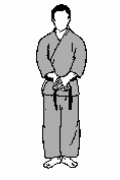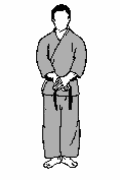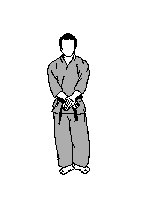



OUR PHILOSOPHY
At Shubukan 修武館 our aim is to bring high quality, accessible self defense sessions to the Calgary community. Our unique approach to combining traditional and innovative martial arts methods and techniques is what separates us from every other Martial Arts School you know.
This organization is under the leadership of our World Chief Instructor, Tetsuji Nakamura sensei and the IOGKF Executive Committee. The IOGKF is committed to preserving the intangible cultural treasure of Okinawan Goju-Ryu Karate-do, which has passed down to us in its original form from one generation to the next.
Our instructors have a wide range of expertise, and are here to train you through every step of the learning process. Whether you’re joining us as a beginner or a professional, there’s always more room to perfect your form. Browse our site to learn more.
OUR CLASSES
Something For Everyone



Okinawan Goju Ryu Kata 沖縄剛柔流 型
Okinawan Goju - Ryu has 12 core kata in its standard curriculum
Gekisai Dai Ichi - 撃砕第一 - Attack and Destruction No. 1
It was created by Miyagi Sensei in 1940 in his desire to popularize Goju-Ryu among young people. It should be noted that this kata ends with a step forward. Japan was at war in the period of time when this kata was created and, according to Higaonna Sensei's book, "The History of Karate-Do", Miyagi Sensei included this step forward as an analogy to the step the country was taking.
Gekisai Dai Ni - 撃砕第第二 - Attack and Destruction No.2
It was created at the same time as Gekisai Dai Ichi. It introduces open-handed techniques and movements in Neko Ashi, important characteristics of some advanced Goju Ryu kata. Both katas, Gekisai Dai ichi and Gekisai Dai ni, are performed with exaggerated movements and are relatively easy to understand.
Saifa - 碎破 - Break, Tear
It employs tai-sabaki (body movements) and various escape techniques.
Seiyunchin - 制引戰 - Controlling, Pulling, Unbalance, also "Calm in the storm"
Seiyunchin is unusual in that no kicking techniques are employed. It contains several escape techniques.
Shisochin - 四向戰 - Four-Way Combat
This kata is said to have been Sensei Miyagi's favorite in his later years. The kata employs joint blocks and four-way combat techniques.
Sanseiru - 三十六手 - Means 36 Hands in Chinese
It means the number 36 in Chinese and is calculated by the formula of 6 times 6. The first 6 represents EYE, EAR, NOSE, TONGUE, BODY AND SPIRIT. The second 6 represents COLOR, VOICE, TASTE, SMELL, TOUCH AND JUSTICE. It employs various joint attacks and defenses against leg techniques.
Sepai - 十八手 - Means 18 Hands in Chinese
It means 18 in Chinese, and is calculated by multiplying 6 by 3. The number 3 stands for GOOD, BAD, AND PEACE. The number 6 has the same representation as the second 6 of the Sanseru kata. Sepai uses several movements that require coordination between the hips and hands. It contains a wide variety of techniques.
Kururunfa - 久留頓破 - Always stopped and attacking suddenly
This kata was passed from Sensei Ryu Ryuko to Sensei Kanryo Higaonna, but its creator remains unknown. Kururunfa contains a number of open-hand techniques and a special coordination of hip techniques and movements in Neko Ashi. Just like Sesan, Kururunfa has smooth movements, followed by hard ones, however the difference between hardness and softness is much more marked.
Sesan - 十三手 - Means 13 Hands in Chinese
Sesan contains very unusual techniques and emphasizes the difference between Go (hard) and Ju (soft). A different version is practiced in Shotokan (Hangetsu) and Wado Ryu (Seishan). Sesan is said to have been the favorite kata of Jin'an Shinzato Sensei and Chojun Miyagi Sensei.
Suparinpei - 壱百零八手 - Means 108 Hands in Chinese
It is the most advanced and complicated kata in Goju-Ryu. It is also sometimes known by the old name of Pitchurrin. It means 108 in Chinese and has a special meaning in Buddhism (it is believed that man has 108 evil passions and that is why in Buddhist temples on December 31 a bell rings 108 times to cast out evil spirits). This number 108 is obtained by multiplying the number 36 (from SANSERU) by the number 3 that symbolizes PAST, PRESENT AND FUTURE.










Sanchin - 三戰 - 3 Battles
The name Sanchin or 3 battles refers to the conflict between mind, body and spirit during the practice of this kata. There are two versions of Sanchin: the version of Kanryo Higaonna and the one developed by Miyagi Sensei (it preserves the essence of the Sanchin kata of the master Kanryo Higaonna, of which it is a variation made with the aim of not letting any part of the body degenerate due to lack of training).
The Sanchin Kata can be thought of as an aspect of the GO (HARD), and the Tensho Kata represents the JU (SOFT).

Tensho - 転掌 - Ten means to roll and Sho means open hand
Miyagi Sensei developed this kata during his research period in Fuzhou, southeastern China, from 1917 to 1921. It is also known as Rokkishu. The purpose of the Tensho kata is to develop the concentration of strength in points centered on the hands, developing smooth movements that generate tremendous power.


OPENING HOURS
TRY IT FREE
Please call 587-707-8983 to arrange a free, no obligation trial class.
Mon: Closed
Tue : 8pm - 9pm
Wed: Closed
Thu : 8pm - 9pm
Fri: Closed
Sat: Closed
Sun: Closed




LINEAGE OF OKINAWAN GOJU-RYU
中国福建省南派少林拳 (Fujian South Shaolin Style (China)
I
リユウリユウコウ Ryu Ryu Ko (China)
I
東恩納寛量 (1853 - 1915) Kanryo Higaonna (Okinawa) 那覇手の大家 - Naha-Te Supreme Master
I
宮城長順 (1888 - 1953) Chojun Miyagi (Okinawa) 剛柔流流祖 Goju-Ryu Founder
I
宮城安ー (1931 - 2009) An'ichi Miyagi (Okinawa)
IOGKF 名誉会長 IOGKF Honorary Chairman
I
新垣修ー (1929 - 2021) Shuichi Aragaki (Okinawa) IOGKF 名誉会長 IOGKF Honorary Chairman
I
東恩納盛男 (1938 - ) Morio Higaonna (Okinawa)
IOGKF 会長 IOGKF Founder
I
中村哲二 (1965- ) Tetsuji Nakamura (Osaka, Japan) IOGKF World Chief Instructor

